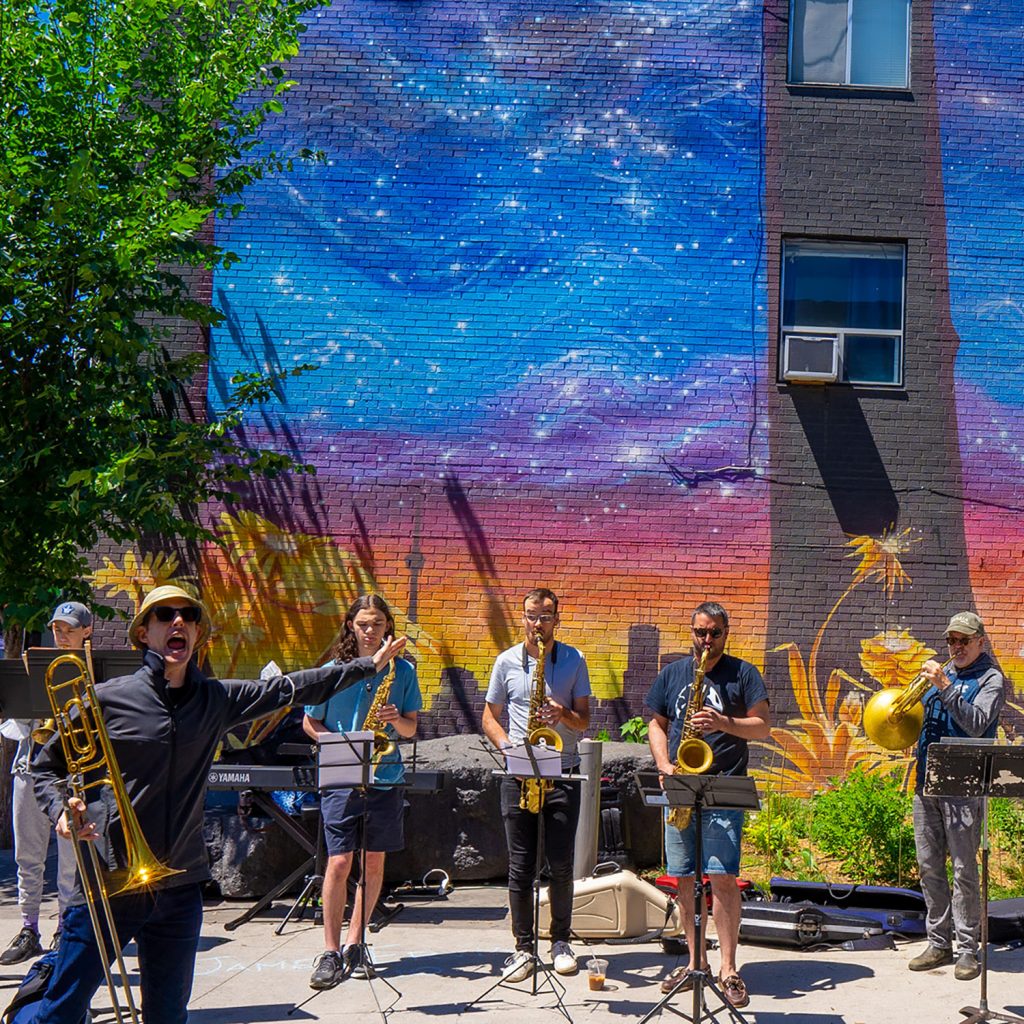Urban design firm DTAH and Bloor-Annex BIA lauded by city

NEILAND BRISSENDEN/GLEANER NEWS
By Megan Bocchinfuso
The Toronto Urban Design Awards (TUDA) are held every other year and recognize Toronto’s exceptional designs in nine categories. This year on Sept. 13, the Bloor-Annex BIA parkettes won the Small Open Spaces Award for their attention to detail, unique granite rock landscaping, and environmental considerations.
The parkettes were designed and brought to life by artist, Robert Cram and landscape architect, James Roche, from the architecture firm DTAH. Cram, Roche and DTAH partnered with the Bloor-Annex BIA in 2019 to design these spaces: 320 Robert St. (adjacent to Metro); 290 Major St. (adjacent to Sleep Country); 306 Brunswick Ave. (adjacent to Value Village Boutique, formerly Brunswick House); and 2 Howland Ave. (adjacent to Slanted Door).
“It was an opportunity to transform the spaces from something that was paved urban space into something that could be more of a positive space,” said Roche.
In order to be considered for a TUDA, each design had to make a positive contribution to the public, successfully integrate with the surrounding urban fabric and heritage elements, follow the city’s urban design guideline, provide barrier-free access, and make a positive contribution to sustainability and environmentalism.
“This project was appreciated simply for what it is and what it is doing for the public realm, but these little details, and some of those thoughtful moments that went into this project, altogether is what made this project award-worthy,” said TUDA jury member Michael Ormston-Holloway.
The Bloor-Annex parkettes are unique in the sense that they were designed for the benefit of the surrounding environment. The spaces were originally asphalt and unused; they are now small spaces with an outsized green impact.
Massive wooden beams from the former Honest Ed’s were used for some of the benches, and the gardens contain mature trees with pollinator plants below. The stone sculptures, which double as seating, were rescued from waste piles in Quebec quarries where they were discarded because of small cracks and fissures.
“The targeting of quarry offcuts, to purpose an element otherwise destined for discarding was a thoughtful detail. Giving home and purpose to an otherwise unvalued material is an appreciated detail,” said Ormston-Holloway.
Cram said the selection of the stones was based on accessibility. Granite is incredibly heavy, and the stones had to be transported from Quebec to Toronto. Cram had to find a “middle ground” and choose the stones that could be transported despite weighing as much as 15 tonnes each.
From there, Cram started the lengthy process of sculpting the stones with a company in Quebec.
Subterranean elements such as water and electricity had to be considered to ensure the stones wouldn’t sink and to honour both the art, design, and structural elements.
“Working with James [Roche] and making sure that we could integrate the art in a way that complimented the design and make it stronger was a huge part of the process,” said Cram.
Using wood decking in the parks was also an environmental feature of the intricate design plan. The sustainable wood allows water to go straight into the ground, nourishing the trees and flowers. The lighting is also environmentally-friendly. The designs feature small soft-glowing lights in the backs of the wooden benches to avoid overhead lighting.
Brian Burchell, manager of the Bloor-Annex BIA (and publisher of this newspaper), said the project was part of a green initiative funded in part by the City of Toronto. It also involved collaborating with the David Suzuki Foundation for the planning of the garden beds “to ensure they were pollinator friendly” and attractive not just to people, but to birds, butterflies, and bees.
“We’re quite proud of that. It’s obviously for visitors, but it’s also about a huge environmental consideration,” said Burchell.
The parkettes are often occupied and in full use. When the pandemic hit in 2020, parks and outdoor spaces became “even more important,” especially for those who did not have balconies or backyards, said Roche. “Our attitudes towards parks and streets and such changed as a result and continue to change.”
Burchell and Roche also acknowledged the importance of the parks during COVID-19 and remarked on how children use the space. They said the parks were not intended to be playgrounds but have caught the attention of children more than they expected.
“I think it was a great validation for a vision that I and many others had for spaces that were normally commercialized,” said Burchell, who advocates for an inclusive and welcoming streetscape. “It was our idea that a rising tide will float all boats, and it has.”
READ MORE:
- FOCUS: Bloor Street BIA parkettes win prestigious design award (Jan. 2023)
- ON THE COVER (Jan. 2020)
- FOCUS: Marked with granite (Jan. 2020)
- CHATTER: Excavators discover giant rock off Bloor Street (August 2019)
- NEWS: BIA behind green plan (Spring 2019)
- CHATTER: No more funding for Annex Family Festival (Jan. 2018)
- Chatter: Bloor Annex BIA updates street revitalization plan (Nov. 2017)
- CHATTER: Bloor Annex BIA showcases street greening plans(DECEMBER 2016)
- CHATTER: Ground-breaking bike lanes launch on Bloor Street (AUGUST 2016)
- NEWS: Bloor Street goes green (April 2016)
